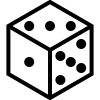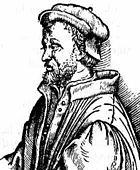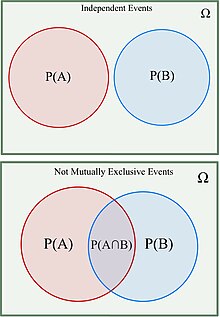Probability
| Probability |
|---|
 |
| Part of a series on statistics |
| Probability theory |
|---|
 |
| Part of a series on | ||
| Mathematics | ||
|---|---|---|
|
|
||
|
| ||

Probability is the branch of mathematics concerning events and numerical descriptions of how likely they are to occur. The probability of an event is a number between 0 and 1; the larger the probability, the more likely an event is to occur.[note 1][1][2] A simple example is the tossing of a fair (unbiased) coin. Since the coin is fair, the two outcomes ("heads" and "tails") are both equally probable; the probability of "heads" equals the probability of "tails"; and since no other outcomes are possible, the probability of either "heads" or "tails" is 1/2 (which could also be written as 0.5 or 50%).
These concepts have been given an
Interpretations
When dealing with random experiments – i.e., experiments that are random and well-defined – in a purely theoretical setting (like tossing a coin), probabilities can be numerically described by the number of desired outcomes, divided by the total number of all outcomes. This is referred to as theoretical probability (in contrast to empirical probability, dealing with probabilities in the context of real experiments). For example, tossing a coin twice will yield "head-head", "head-tail", "tail-head", and "tail-tail" outcomes. The probability of getting an outcome of "head-head" is 1 out of 4 outcomes, or, in numerical terms, 1/4, 0.25 or 25%. However, when it comes to practical application, there are two major competing categories of probability interpretations, whose adherents hold different views about the fundamental nature of probability:
- Objectivists assign numbers to describe some objective or physical state of affairs. The most popular version of objective probability is frequentist probability, which claims that the probability of a random event denotes the relative frequency of occurrence of an experiment's outcome when the experiment is repeated indefinitely. This interpretation considers probability to be the relative frequency "in the long run" of outcomes.[4] A modification of this is propensity probability, which interprets probability as the tendency of some experiment to yield a certain outcome, even if it is performed only once.
- posterior probability distribution that incorporates all the information known to date.[8] By Aumann's agreement theorem, Bayesian agents whose prior beliefs are similar will end up with similar posterior beliefs. However, sufficiently different priors can lead to different conclusions, regardless of how much information the agents share.[9]
Etymology
The word probability derives from the Latin probabilitas, which can also mean "probity", a measure of the authority of a witness in a legal case in Europe, and often correlated with the witness's nobility. In a sense, this differs much from the modern meaning of probability, which in contrast is a measure of the weight of empirical evidence, and is arrived at from inductive reasoning and statistical inference.[10]
History
The scientific study of probability is a modern development of mathematics. Gambling shows that there has been an interest in quantifying the ideas of probability throughout history, but exact mathematical descriptions arose much later. There are reasons for the slow development of the mathematics of probability. Whereas games of chance provided the impetus for the mathematical study of probability, fundamental issues [note 2] are still obscured by superstitions.[11]
According to Richard Jeffrey, "Before the middle of the seventeenth century, the term 'probable' (Latin probabilis) meant approvable, and was applied in that sense, univocally, to opinion and to action. A probable action or opinion was one such as sensible people would undertake or hold, in the circumstances."[12] However, in legal contexts especially, 'probable' could also apply to propositions for which there was good evidence.[13]


The sixteenth-century Italian polymath Gerolamo Cardano demonstrated the efficacy of defining odds as the ratio of favourable to unfavourable outcomes (which implies that the probability of an event is given by the ratio of favourable outcomes to the total number of possible outcomes[14]). Aside from the elementary work by Cardano, the doctrine of probabilities dates to the correspondence of
The
The first two laws of error that were proposed both originated with Pierre-Simon Laplace. The first law was published in 1774, and stated that the frequency of an error could be expressed as an exponential function of the numerical magnitude of the error – disregarding sign. The second law of error was proposed in 1778 by Laplace, and stated that the frequency of the error is an exponential function of the square of the error.[19] The second law of error is called the normal distribution or the Gauss law. "It is difficult historically to attribute that law to Gauss, who in spite of his well-known precocity had probably not made this discovery before he was two years old."[19]
Daniel Bernoulli (1778) introduced the principle of the maximum product of the probabilities of a system of concurrent errors.

where is a constant depending on precision of observation, and is a scale factor ensuring that the area under the curve equals 1. He gave two proofs, the second being essentially the same as
In the nineteenth century, authors on the general theory included
improved the exposition of the theory.In 1906,
On the geometric side, contributors to The Educational Times included Miller, Crofton, McColl, Wolstenholme, Watson, and Artemas Martin.[23] See integral geometry for more information.
Theory
Like other theories, the theory of probability is a representation of its concepts in formal terms – that is, in terms that can be considered separately from their meaning. These formal terms are manipulated by the rules of mathematics and logic, and any results are interpreted or translated back into the problem domain.
There have been at least two successful attempts to formalize probability, namely the
There are other methods for quantifying uncertainty, such as the Dempster–Shafer theory or possibility theory, but those are essentially different and not compatible with the usually-understood laws of probability.
Applications
Probability theory is applied in everyday life in
An example of the use of probability theory in equity trading is the effect of the perceived probability of any widespread Middle East conflict on oil prices, which have ripple effects in the economy as a whole. An assessment by a commodity trader that a war is more likely can send that commodity's prices up or down, and signals other traders of that opinion. Accordingly, the probabilities are neither assessed independently nor necessarily rationally. The theory of
In addition to financial assessment, probability can be used to analyze trends in biology (e.g., disease spread) as well as ecology (e.g., biological
Another significant application of probability theory in everyday life is
The
Mathematical treatment

Consider an experiment that can produce a number of results. The collection of all possible results is called the sample space of the experiment, sometimes denoted as . The power set of the sample space is formed by considering all different collections of possible results. For example, rolling a die can produce six possible results. One collection of possible results gives an odd number on the die. Thus, the subset {1,3,5} is an element of the power set of the sample space of dice rolls. These collections are called "events". In this case, {1,3,5} is the event that the die falls on some odd number. If the results that actually occur fall in a given event, the event is said to have occurred.
A probability is a way of assigning every event a value between zero and one, with the requirement that the event made up of all possible results (in our example, the event {1,2,3,4,5,6}) is assigned a value of one. To qualify as a probability, the assignment of values must satisfy the requirement that for any collection of mutually exclusive events (events with no common results, such as the events {1,6}, {3}, and {2,4}), the probability that at least one of the events will occur is given by the sum of the probabilities of all the individual events.[28]
The probability of an event A is written as ,[29] , or .[30] This mathematical definition of probability can extend to infinite sample spaces, and even uncountable sample spaces, using the concept of a measure.
The opposite or complement of an event A is the event [not A] (that is, the event of A not occurring), often denoted as , , or ; its probability is given by P(not A) = 1 − P(A).[31] As an example, the chance of not rolling a six on a six-sided die is 1 – (chance of rolling a six) = 1 − 1/6 = 5/6. For a more comprehensive treatment, see Complementary event.
If two events A and B occur on a single performance of an experiment, this is called the intersection or
Independent events
If two events, A and B are independent then the joint probability is[29]

For example, if two coins are flipped, then the chance of both being heads is [32]
Mutually exclusive events
If either event A or event B can occur but never both simultaneously, then they are called mutually exclusive events.
If two events are
Not (necessarily) mutually exclusive events
If the events are not (necessarily) mutually exclusive then
This can be expanded further for multiple not (necessarily) mutually exclusive events. For three events, this proceeds as follows:
Conditional probability
Conditional probability is the probability of some event A, given the occurrence of some other event B. Conditional probability is written , and is read "the probability of A, given B". It is defined by[33]
For example, in a bag of 2 red balls and 2 blue balls (4 balls in total), the probability of taking a red ball is however, when taking a second ball, the probability of it being either a red ball or a blue ball depends on the ball previously taken. For example, if a red ball was taken, then the probability of picking a red ball again would be since only 1 red and 2 blue balls would have been remaining. And if a blue ball was taken previously, the probability of taking a red ball will be
Inverse probability
In probability theory and applications, Bayes' rule relates the odds of event to event before (prior to) and after (posterior to) conditioning on another event The odds on to event is simply the ratio of the probabilities of the two events. When arbitrarily many events are of interest, not just two, the rule can be rephrased as posterior is proportional to prior times likelihood, where the proportionality symbol means that the left hand side is proportional to (i.e., equals a constant times) the right hand side as varies, for fixed or given (Lee, 2012; Bertsch McGrayne, 2012). In this form it goes back to Laplace (1774) and to Cournot (1843); see Fienberg (2005). See
Summary of probabilities
| Event | Probability |
|---|---|
| A | |
| not A | |
| A or B | |
| A and B | |
| A given B |
Relation to randomness and probability in quantum mechanics
In a
See also
Notes
- ^ Strictly speaking, a probability of 0 indicates that an event almost never takes place, whereas a probability of 1 indicates than an event almost certainly takes place. This is an important distinction when the sample space is infinite. For example, for the continuous uniform distribution on the real interval [5, 10], there are an infinite number of possible outcomes, and the probability of any given outcome being observed — for instance, exactly 7 — is 0. This means that an observation will almost surely not be exactly 7. However, it does not mean that exactly 7 is impossible. Ultimately some specific outcome (with probability 0) will be observed, and one possibility for that specific outcome is exactly 7.
- ^ In the context of the book that this is quoted from, it is the theory of probability and the logic behind it that governs the phenomena of such things compared to rash predictions that rely on pure luck or mythological arguments such as gods of luck helping the winner of the game.
References
- ISBN 978-0-534-24312-8.
- ISBN 0-471-25708-7.
- ^ Probability Theory. The Britannica website.
- ISBN 978-0-521-05165-1.[page needed]
- .
- ^ Hájek, Alan (21 October 2002). Edward N. Zalta (ed.). "Interpretations of Probability". The Stanford Encyclopedia of Philosophy (Winter 2012 ed.). Retrieved 22 April 2013.
- ISBN 978-0-521-59271-0.
- ISBN 978-0-13-008507-8.[page needed]
- ISBN 978-0-521-59271-0.
- ^ ISBN 978-0-521-68557-3 [page needed]
- ISBN 978-0-8221-0078-2(p. 1)
- ISBN 0-521-39459-7
- ^ Franklin, J. (2001) The Science of Conjecture: Evidence and Probability Before Pascal, Johns Hopkins University Press. (pp. 22, 113, 127)
- ^ "Some laws and problems in classical probability and how Cardano anticipated them Gorrochum, P. Chance magazine 2012" (PDF).
- ^ Abrams, William. A Brief History of Probability. Second Moment. Archived from the original on 24 July 2017. Retrieved 23 May 2008.
- ISBN 978-981-281-927-7.
- ISBN 978-0-8018-6569-5.
- .
- ^ a b Wilson EB (1923) "First and second laws of error". Journal of the American Statistical Association, 18, 143
- ^ Seneta, Eugene William. ""Adrien-Marie Legendre" (version 9)". StatProb: The Encyclopedia Sponsored by Statistics and Probability Societies. Archived from the original on 3 February 2016. Retrieved 27 January 2016.
- ^ Weber, Richard. "Markov Chains" (PDF). Statistical Laboratory. University of Cambridge.
- ^ Vitanyi, Paul M.B. (1988). "Andrei Nikolaevich Kolmogorov". CWI Quarterly (1): 3–18. Retrieved 27 January 2016.
- )
- ^ Singh, Laurie (2010) "Whither Efficient Markets? Efficient Market Theory and Behavioral Finance". The Finance Professionals' Post, 2010.
- PMID 22964834. pp. 5–6:
[…] Punnett's square seems to have been a development of 1905, too late for the first edition of his Mendelism (May 1905) but much in evidence in Report III to the Evolution Committee of the Royal Society [(Bateson et al. 1906b) "received March 16, 1906"]. The earliest mention is contained in a letter to Bateson from Francis Galton dated October 1, 1905 (Edwards 2012). We have the testimony of Bateson (1909, p. 57) that "For the introduction of this system [the 'graphic method'], which greatly simplifies difficult cases, I am indebted to Mr. Punnett." […] The first published diagrams appeared in 1906. […] when Punnett published the second edition of his Mendelism, he used a slightly different format ([…] Punnett 1907, p. 45) […] In the third edition (Punnett 1911, p. 34) he reverted to the arrangement […] with a description of the construction of what he called the "chessboard" method (although in truth it is more like a multiplication table). […]
(11 pages) - S2CID 144540412.
- .
- ISBN 9780136033134.
- ^ a b Weisstein, Eric W. "Probability". mathworld.wolfram.com. Retrieved 10 September 2020.
- ^ Olofsson (2005) p. 8.
- ^ Olofsson (2005), p. 9
- ^ Olofsson (2005) p. 35.
- ^ Olofsson (2005) p. 29.
- ^ "Conditional probability with respect to a sigma-algebra". www.statlect.com. Retrieved 4 July 2022.
- ^ Riedi, P.C. (1976). Kinetic Theory of Gases-I. In: Thermal Physics. Palgrave, London. https://doi.org/10.1007/978-1-349-15669-6_8
- arXiv:1008.1287v1 [physics.data-an].
- ^ Jedenfalls bin ich überzeugt, daß der Alte nicht würfelt. Letter to Max Born, 4 December 1926, in: Einstein/Born Briefwechsel 1916–1955.
- ISBN 978-0-521-43767-7.
Bibliography
- ISBN 0-387-25115-4
- Kallenberg, O. (2002) Foundations of Modern Probability, 2nd ed. Springer Series in Statistics. 650 pp. ISBN 0-387-95313-2
- Olofsson, Peter (2005) Probability, Statistics, and Stochastic Processes, Wiley-Interscience. 504 pp ISBN 0-471-67969-0.
External links
- Virtual Laboratories in Probability and Statistics (Univ. of Ala.-Huntsville)
- Probability on In Our Time at the BBC
- Probability and Statistics EBook
- Edwin Thompson Jaynes. Probability Theory: The Logic of Science. Preprint: Washington University, (1996). – HTML index with links to PostScript files and PDF (first three chapters)
- People from the History of Probability and Statistics (Univ. of Southampton)
- Probability and Statistics on the Earliest Uses Pages (Univ. of Southampton)
- Earliest Uses of Symbols in Probability and Statistics on Earliest Uses of Various Mathematical Symbols
- A tutorial on probability and Bayes' theorem devised for first-year Oxford University students
- U B U W E B :: La Monte Young pdf file of An Anthology of Chance Operations (1963) at UbuWeb
- Introduction to Probability – eBook Archived 27 July 2011 at the Wayback Machine, by Charles Grinstead, Laurie Snell Source Archived 25 March 2012 at the Wayback Machine (GNU Free Documentation License)
- (in English and Italian) ISBN 88-8091-176-7(digital version)
- Richard Feynman's Lecture on probability.





































![{\displaystyle P(A)\in [0,1]}](https://wikimedia.org/api/rest_v1/media/math/render/svg/8f07aab47c06682ab4a8b4934f5db8c813e3eff6)



